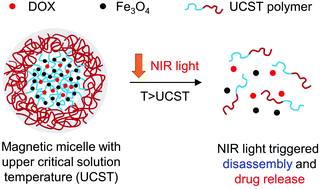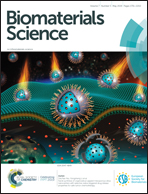Magnetic thermosensitive micelles with upper critical solution temperature for NIR triggered drug release†
Abstract
Smart micelles which undergo dramatic property changes in response to temperature have aroused extensive interest in specific cancer therapy. To date, studies on thermosensitive polymers have mainly focused on lower critical solution temperature (LCST) polymers. Materials with upper critical solution temperature (UCST) which can swell and disassemble at elevated temperatures have much less been documented, although they have been reported to be ideal carriers for quick and complete drug release upon applying a stimulus. Here, magnetic micelles with UCST are developed for doxorubicin (DOX) delivery. Hydrophobic Fe3O4 magnetic nanoparticles with a particle size of 8 nm are fabricated and enveloped in an amphiphilic polymer, poly(AAm-co-AN)-g-PEG (PAAP), to form UCST micelles (Fe3O4@PAAP). The resulting micelles exhibit excellent photothermal effects and burst drug release in response to near infrared (NIR) laser irradiation. The in vitro and in vivo antitumor experiments indicate that DOX-Fe3O4@PAAP micelles can significantly enhance the therapeutic effect upon NIR light irradiation. A novel thermosensitive platform is thus offered for in situ drug release and combined photothermal-chemotherapy, holding a favorable prospect for cancer therapy.



 Please wait while we load your content...
Please wait while we load your content...